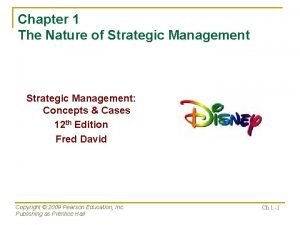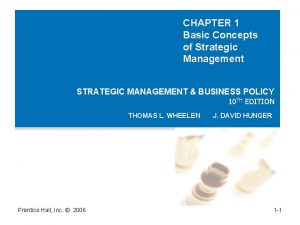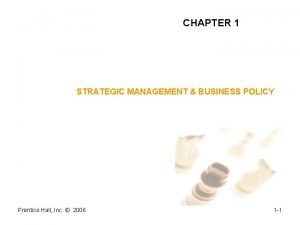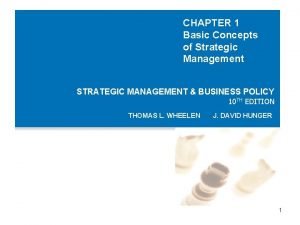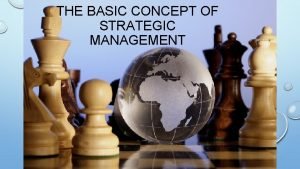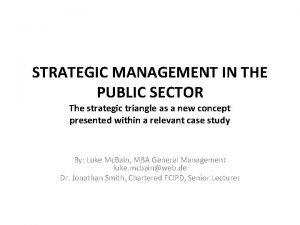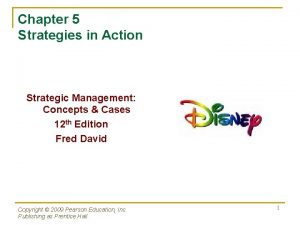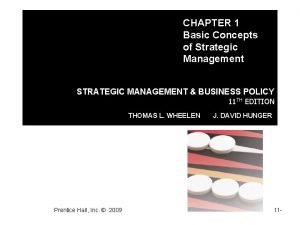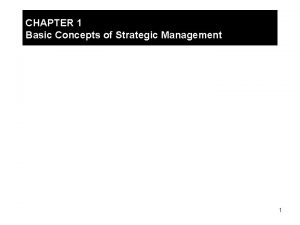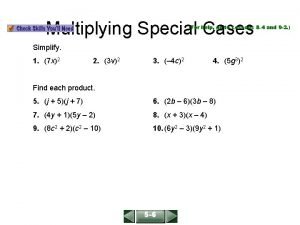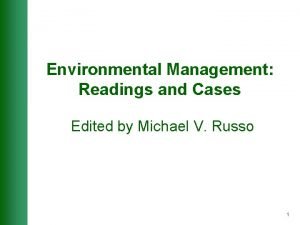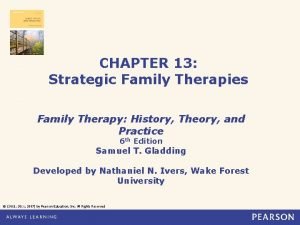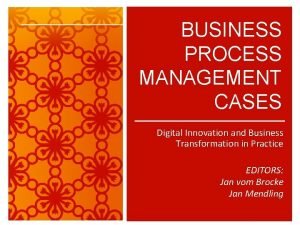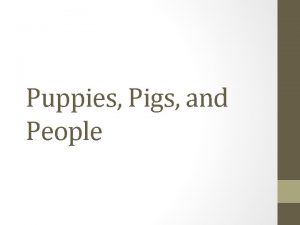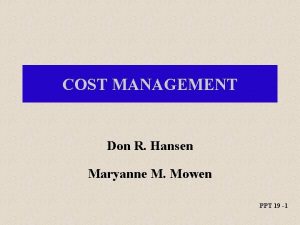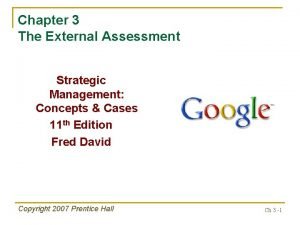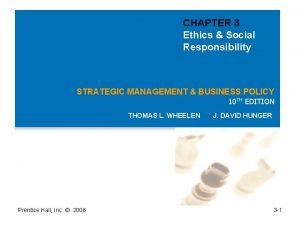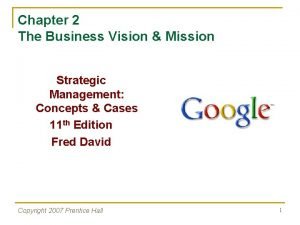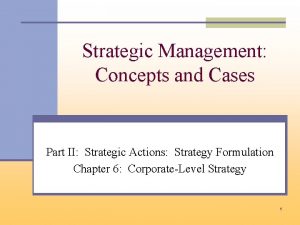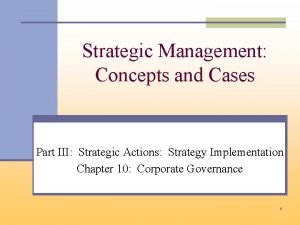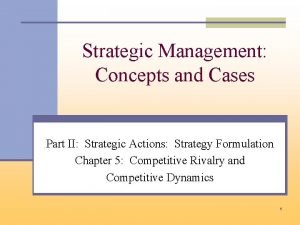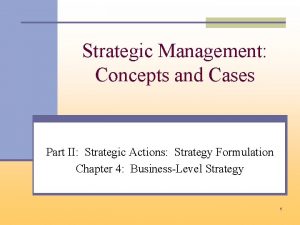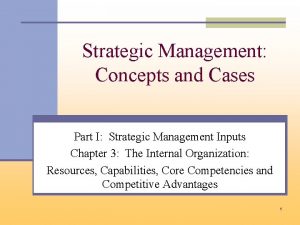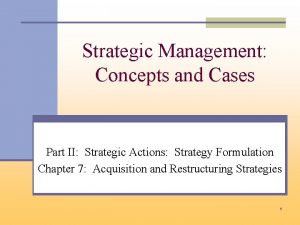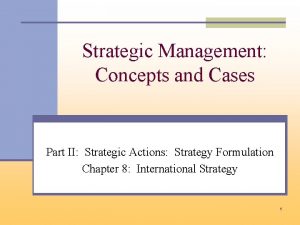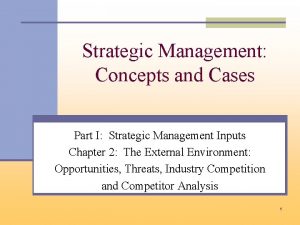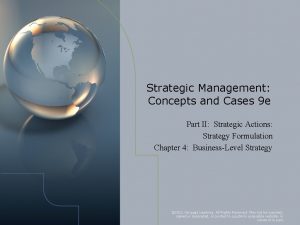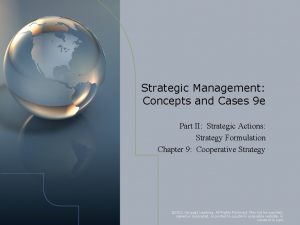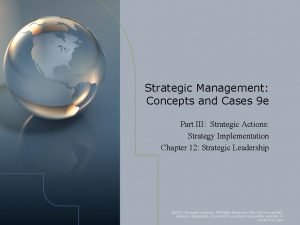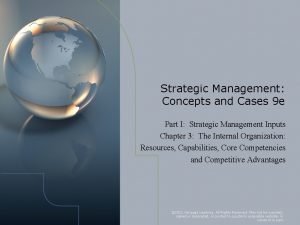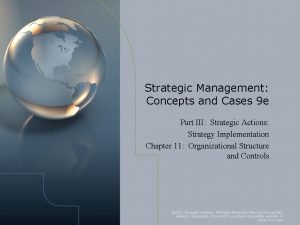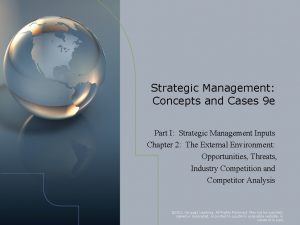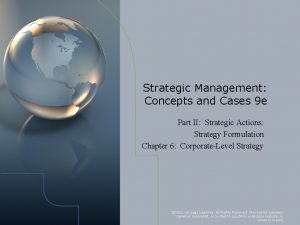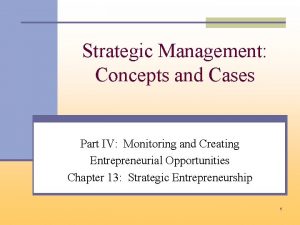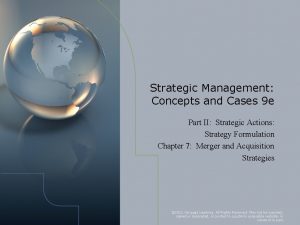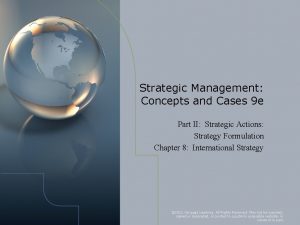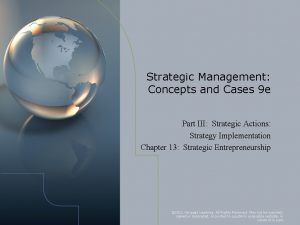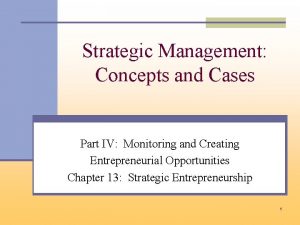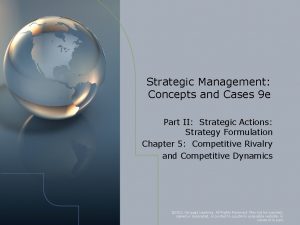Strategic Management Concepts and Cases 9 e Part




















![The Resource-Based Model of AAR (Cont’d) • Basic Premise - a firm's unique [internal] The Resource-Based Model of AAR (Cont’d) • Basic Premise - a firm's unique [internal]](https://slidetodoc.com/presentation_image_h2/b589c915e3171bfea74ee8f6a210c621/image-21.jpg)











- Slides: 32

Strategic Management: Concepts and Cases 9 e Part I: Strategic Management Inputs Chapter 1: Strategic Management and Strategic Competitiveness © 2011 Cengage Learning. All Rights Reserved. May not be scanned, copied or duplicated, or posted to a publicly accessible website, in whole or in part.

Chapter 1: Strategic Management and Strategic Competitiveness • Overview: Eight content areas – Nature of Competition – The Competitive Landscape – I/O Model of Above-Average Returns (AAR) – Resource-Based Model of AAR – Vision and Mission – Stakeholders – Strategic Leaders – The Strategic Management Process © 2011 Cengage Learning. All Rights Reserved. May not be scanned, copied or duplicated, or posted to a publicly accessible website, in whole or in part.

Nature of Competition: Mc. Donald’s • Mc. Donald’s creates value for customers through: – Business-level strategies • Product Innovation • Upgrading existing restaurants • Listened to customers – value menu, healthier items, more convenience • Purchasing European property for future expansion – Corporate-level strategies • Disposed of its interests in other restaurants © 2011 Cengage Learning. All Rights Reserved. May not be scanned, copied or duplicated, or posted to a publicly accessible website, in whole or in part.

Nature of Competition: Basic concepts • Strategic Competitiveness – Achieved when a firm formulate & implements a valuecreating strategy • Strategy – Integrated and coordinated set of commitments and actions designed to exploit core competencies and gain a competitive advantage • Competitive Advantage (CA) – Implemented strategy that competitors are unable to duplicate or find too costly to imitate • Above Average Returns – Returns in excess of what investor expects in comparison to other investments with similar risk © 2011 Cengage Learning. All Rights Reserved. May not be scanned, copied or duplicated, or posted to a publicly accessible website, in whole or in part.

Nature of Competition: Basic concepts (Cont’d) • Risk – Investor’s uncertainty about economic gains/losses resulting from a particular investment • Average Returns – Returns equal to what investor expects in comparison to other investments with similar risk • Strategic Management Process (SMP) – Full set of commitments, decisions and actions required for a firm to achieve strategic competitiveness and earn above average returns © 2011 Cengage Learning. All Rights Reserved. May not be scanned, copied or duplicated, or posted to a publicly accessible website, in whole or in part.

The Strategic Management Process © 2011 Cengage Learning. All Rights Reserved. May not be scanned, copied or duplicated, or posted to a publicly accessible website, in whole or in part.

Chapter 1: Strategic Management and Strategic Competitiveness • Overview: Eight content areas – Nature of Competition – The Competitive Landscape – I/O Model of Above-Average Returns (AAR) – Resource-Based Model of AAR – Strategic Vision and Mission – Stakeholders – Strategic Leaders – The Strategic Management Process © 2011 Cengage Learning. All Rights Reserved. May not be scanned, copied or duplicated, or posted to a publicly accessible website, in whole or in part.

The Competitive Landscape • Introduction: The Competitive Landscape (CL) – Pace of change is rapid – Industry boundaries are blurring – Financial capital is more scarce and markets are increasingly volatile – Other CL characteristics: Economies of scale, advertising budgets not as effective as before, change in managerial mind-set from “traditional” to more flexible and innovative © 2011 Cengage Learning. All Rights Reserved. May not be scanned, copied or duplicated, or posted to a publicly accessible website, in whole or in part.

The Competitive Landscape (Cont’d) • Introduction: The Competitive Landscape (CL) – Hypercompetition – extremely intense rivalry among competing firms, characterized by • Escalating & increasingly aggressive competitive moves • Assumptions of market stability replaced with notion of INstability and change – Two primary drivers of the competitive landscape: • The global economy • Technology © 2011 Cengage Learning. All Rights Reserved. May not be scanned, copied or duplicated, or posted to a publicly accessible website, in whole or in part.

The Competitive Landscape (Cont’d) • The Global Economy – Goods, services, people, skills and ideas move freely across geographic borders – Europe, through the European Union (EU) is the world’s largest single market • EU vs U. S. GDP: 35% higher – Emerging major competitive forces: China & India – In summary: globalization increased economic interdependence among countries as reflected in the flow of goods and services, financial capital, and knowledge across country borders © 2011 Cengage Learning. All Rights Reserved. May not be scanned, copied or duplicated, or posted to a publicly accessible website, in whole or in part.

The Competitive Landscape (Cont’d) • Technology and Technological Changes – 3 categories: • 1. Technology diffusion & disruptive technologies • 2. The information age • 3. Increasing knowledge intensity © 2011 Cengage Learning. All Rights Reserved. May not be scanned, copied or duplicated, or posted to a publicly accessible website, in whole or in part.

The Competitive Landscape (Cont’d) • Technology and Technology Changes (Cont’d) – Technology diffusion • Perpetual innovation: describes how new information-intensive technologies are replacing older forms • Speed to market may be primary competitive advantage • 12 – 18 month timeframe to gather info re: competitor R&D – Disruptive technologies • Technologies that – Destroy value of existing technology – Create new markets © 2011 Cengage Learning. All Rights Reserved. May not be scanned, copied or duplicated, or posted to a publicly accessible website, in whole or in part.

The Competitive Landscape (Cont’d) • Technology and Technology Changes (Cont’d) – 1. Technology diffusion & disruptive technologies – 2. The information age – 3. Increasing knowledge intensity © 2011 Cengage Learning. All Rights Reserved. May not be scanned, copied or duplicated, or posted to a publicly accessible website, in whole or in part.

The Competitive Landscape (Cont’d) • Technology and Technology Changes (Cont’d) – The information age • Dramatic changes over last several years • Major technological developments effect how information is used and disseminated • Internet provides infrastructure for information anytime, anywhere – Increasing knowledge intensity • Defined as information, intelligence & expertise and is the basis of technology and its application • Gained through experience, observations and inferences • Strategic Flexibility – set of capabilities used to respond to various demands and opportunities existing in a dynamic and uncertain competitive environment © 2011 Cengage Learning. All Rights Reserved. May not be scanned, copied or duplicated, or posted to a publicly accessible website, in whole or in part.

Chapter 1: Strategic Management and Strategic Competitiveness • Overview: Eight content areas – Nature of Competition – The Competitive Landscape – I/O Model of Above-Average Returns (AAR) – Resource-Based Model of AAR – Strategic Vision and Mission – Stakeholders – Strategic Leaders – The Strategic Management Process © 2011 Cengage Learning. All Rights Reserved. May not be scanned, copied or duplicated, or posted to a publicly accessible website, in whole or in part.

Industrial Organizational (I/O) Model of Above-Average Returns (AAR) © 2011 Cengage Learning. All Rights Reserved. May not be scanned, copied or duplicated, or posted to a publicly accessible website, in whole or in part.

Industrial Organizational (I/O) Model of Above-Average Returns (AAR) • Basic Premise – to explain the dominant influence of the external environment on a firm's strategic actions and performance © 2011 Cengage Learning. All Rights Reserved. May not be scanned, copied or duplicated, or posted to a publicly accessible website, in whole or in part.

Industrial Organizational (I/O) Model of Above-Average Returns (AAR) • Underlying Assumptions – External environment imposes pressures and constraints that determine the strategies resulting in AAR – Most firms compete within a particular industry/segment • Control similar strategically relevant resources • Pursue similar strategies in light of those resources – Resources for implementing strategies are highly mobile across firms • Therefore any resource differences between firms will be short -lived – Organizational decision makers are rational and committed to acting in the firm's best interests, as shown by their profit-maximizing behaviors © 2011 Cengage Learning. All Rights Reserved. May not be scanned, copied or duplicated, or posted to a publicly accessible website, in whole or in part.

Industrial Organizational (I/O) Model of Above-Average Returns (AAR) • Five-Forces Model (Michael Porter) – The 5 Forces includes • Suppliers, buyers, competitive rivalry, product substitutes and potential entrants – Reinforces the importance of economic theory – Analytical tool previously lacking in the field of strategy – Determines the nature/level of competition and profit potential in an industry • Suggests an industry’s profitability is an interaction between these 5 forces © 2011 Cengage Learning. All Rights Reserved. May not be scanned, copied or duplicated, or posted to a publicly accessible website, in whole or in part.

The Resource-Based Model of AAR © 2011 Cengage Learning. All Rights Reserved. May not be scanned, copied or duplicated, or posted to a publicly accessible website, in whole or in part.
![The ResourceBased Model of AAR Contd Basic Premise a firms unique internal The Resource-Based Model of AAR (Cont’d) • Basic Premise - a firm's unique [internal]](https://slidetodoc.com/presentation_image_h2/b589c915e3171bfea74ee8f6a210c621/image-21.jpg)
The Resource-Based Model of AAR (Cont’d) • Basic Premise - a firm's unique [internal] resources & capabilities, in combination, are the basis for firm strategy and AAR – Each firm’s performance difference across time emerges (vs industry’s structural characteristics) – Combined uniqueness should define the firms’ strategic actions – Resources are tangible and intangible © 2011 Cengage Learning. All Rights Reserved. May not be scanned, copied or duplicated, or posted to a publicly accessible website, in whole or in part.

The Resource-Based Model of AAR (Cont’d) • Resources – Inputs into a firm's production process • Includes capital equipment, employee skills, patents, highquality managers, financial condition, etc. – Basis for competitive advantage: When resources are valuable, rare, costly to imitate and nonsubstitutable – Internal/firm-specific resources can be classified into three categories: • Physical – Things you can touch/feel = tangible • Human – People / employees • Organizational capital – Relative to the firm itself © 2011 Cengage Learning. All Rights Reserved. May not be scanned, copied or duplicated, or posted to a publicly accessible website, in whole or in part.

The Resource-Based Model of AAR (Cont’d) • Capability – Capacity for a set of resources to perform a task or activity in an integrative manner • Core Competency – A firm’s resources and capabilities that serve as sources of competitive advantage over its rival • Summary – A firm has superior performance because of • Unique resources and capabilities, and the combination makes them different, and better, than their competition – driving the competitive advantage © 2011 Cengage Learning. All Rights Reserved. May not be scanned, copied or duplicated, or posted to a publicly accessible website, in whole or in part.

Chapter 1: Strategic Management and Strategic Competitiveness • Overview: Eight content areas – Nature of Competition – The Competitive Landscape – I/O Model of Above-Average Returns (AAR) – Resource-Based Model of AAR – Vision and Mission – Stakeholders – Strategic Leaders – The Strategic Management Process © 2011 Cengage Learning. All Rights Reserved. May not be scanned, copied or duplicated, or posted to a publicly accessible website, in whole or in part.

Vision and Mission • Vision – Picture of what the firm wants to be and, in broad terms, what it ultimately wants to achieve – An effective vision statement is the responsibility of the leader who should work with others to form it – Foundation for the mission • Mission – Specifics business(es) in which firm intends to compete and customers it intends to serve – More concrete than the vision © 2011 Cengage Learning. All Rights Reserved. May not be scanned, copied or duplicated, or posted to a publicly accessible website, in whole or in part.

Stakeholders • Basic Premise – a firm can effectively manage stakeholder relationships to create a competitive advantage and outperform its competitors • Stakeholders are both individuals and groups – They can affect, and are affected by, the strategic outcomes/performance a firm achieves • Firms are not equally dependent on all stakeholders © 2011 Cengage Learning. All Rights Reserved. May not be scanned, copied or duplicated, or posted to a publicly accessible website, in whole or in part.

The Three Stakeholder Groups © 2011 Cengage Learning. All Rights Reserved. May not be scanned, copied or duplicated, or posted to a publicly accessible website, in whole or in part.

Stakeholders (Cont’d) • Classifications of Stakeholders – Capital Market • Expect returns commiserate with risk accepted by investments • Higher the dependency relationship, the more direct and significant firm’s response – Product Market • Customers, suppliers, host communities, unions – Organizational • The employees • © 2011 Cengage Learning. All Rights Reserved. May not be scanned, copied or duplicated, or posted to a publicly accessible website, in whole or in part.

Chapter 1: Strategic Management and Strategic Competitiveness • Overview: Eight content areas – Nature of Competition – The Competitive Landscape – I/O Model of Above-Average Returns (AAR) – Resource-Based Model of AAR – Strategic Vision and Mission – Stakeholders – Strategic Leaders – The Strategic Management Process © 2011 Cengage Learning. All Rights Reserved. May not be scanned, copied or duplicated, or posted to a publicly accessible website, in whole or in part.

Strategic Leaders • People located in different parts of the firm using the strategic management process to help the firm reach its vision and mission – Decisive and committed to nurturing those around them – Organizational culture emerges from & sustained by leaders • Complex set of ideologies, symbols and core values shared throughout the firm • Affects leaders/their work which in-turn shapes culture • Influences how the firm conducts business © 2011 Cengage Learning. All Rights Reserved. May not be scanned, copied or duplicated, or posted to a publicly accessible website, in whole or in part.

Strategic Leaders (Cont’d) • The Work of Effective Strategic Leaders – Hard work, thorough analysis, desire for accomplishment, tenacity – Must be able to “think seriously and deeply…about the purposes of the organizations they head or functions they perform, about strategies, tactics, …. . and people…and about the important questions … they need to ask. ” • Predicting Outcomes: Profit Pools (PP) – Anticipates their decisions relative to the PP – PP entails the total profits earned in an industry at all points along the value chain © 2011 Cengage Learning. All Rights Reserved. May not be scanned, copied or duplicated, or posted to a publicly accessible website, in whole or in part.

Strategic Management Process • Rational approach used by firms to achieve strategic competitiveness and earn above-average returns (AAR) • Figure 1. 1 (Diagram of chapter relationships) – Part 1: 2: 3: 4: Strategic Mgmt Inputs Strategic Actions: Strategy Formulation Strategic Actions: Strategy Implementation Cases © 2011 Cengage Learning. All Rights Reserved. May not be scanned, copied or duplicated, or posted to a publicly accessible website, in whole or in part.
 Criminal cases vs civil cases
Criminal cases vs civil cases Industrial organization model of above average returns
Industrial organization model of above average returns Strategy analysis and choice largely involves making
Strategy analysis and choice largely involves making Business ethics in strategic management
Business ethics in strategic management Basic concepts of strategic management
Basic concepts of strategic management Basic concept of strategic management
Basic concept of strategic management Basic concepts of strategic management
Basic concepts of strategic management Basic concepts of strategic management
Basic concepts of strategic management Strategic management in the public sector
Strategic management in the public sector Strategic management concepts
Strategic management concepts Strategic management decision making process
Strategic management decision making process A strategic decision is rare, consequential, and directive.
A strategic decision is rare, consequential, and directive. Multiplying special cases
Multiplying special cases Bertrand strategic complements
Bertrand strategic complements Analyzing transactions
Analyzing transactions Eb = p x a x t
Eb = p x a x t Haley strategic family therapy
Haley strategic family therapy Strategic fit vs strategic intent
Strategic fit vs strategic intent Business process management cases
Business process management cases Puppies pigs and people
Puppies pigs and people Part part whole addition
Part part whole addition Unit ratio definition
Unit ratio definition Part part whole
Part part whole Technical description
Technical description Parts of the front bar
Parts of the front bar The phase of the moon you see depends on ______.
The phase of the moon you see depends on ______. Part to part variation
Part to part variation Managerial process of crafting and executing strategy
Managerial process of crafting and executing strategy Ethics in strategic management
Ethics in strategic management Cost management hansen
Cost management hansen Efe matrix of apple
Efe matrix of apple Chapter 3 ethics and social responsibility
Chapter 3 ethics and social responsibility Mission in strategic management
Mission in strategic management



